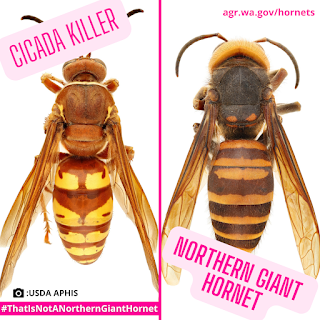Cassie Cichorz
Pest Program
If you can familiarize yourself with some features of the
look-alike insect in the spotlight, you’ll be able to identify differences. The
western cicada killer is a very common native wasp that can be almost as large
as a northern giant hornet. Cicada killers can be seen from late spring and
throughout the summer.
Cicada killers can be up to two inches long, just like the
northern giant hornet. Differences in their head, thorax, or abdomen will help
you distinguish between the two species. The heads of cicada killers are narrower
than their thorax, while the northern giant hornet has a head as wide as its thorax. The cicada killer has round eyes, unlike the angular eyes of giant hornets.
The thorax on a cicada killer is reddish in color, while the northern giant hornet’s is black. The cicada killer’s thorax and head are about the same color, unlike the contrasting head and thorax of the northern giant hornet. Both wasps have translucent, amber-colored wings.You can also check the banding on the abdomen for differences. The northern giant hornet has horizontal lateral bands or striping on its abdomen. The cicada killer’s bands will drop down like teardrops, or have dots between the bands.
Female cicada killers are solitary and dig their nests in the ground. You will often find their nests around areas with lots of sunlight, and sometimes you will see a mound of dirt near the entrance. Cicada killers do not actively defend their nests normally. Males can be territorial, but they do not have a stinger.
Northern giant hornet nests can be underground or in tree cavities.
Unlike cicada killers, hornets are social and live in large colonies – which
they will vigorously defend. Away from the nest, hornets are typically
non-aggressive unless provoked.
WSDA has other information on look-alike insects, including
a poster guide available for use and download. Click
here to learn more about identification. Cicada killers do not need to be reported, but if you suspect you’ve seen a giant hornet in Washington State or are not sure if what you have seen is one or not, get a
photo and report it at agr.wa.gov/hornets.



